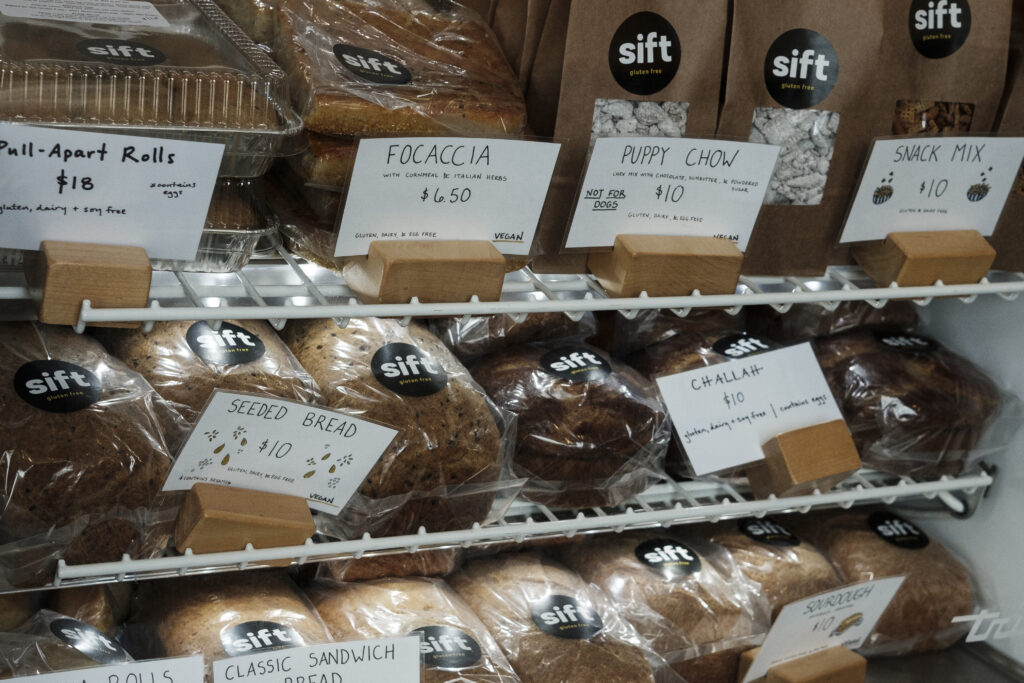
Going Against the Grain
Navigating Life at UMN with Celiac Disease
By Gemma Gardner
A Celiac safe bread close-up in a photo light studio box in Minneapolis on March 2, 2024. Photo by Rosalind Ding
Confession: A salad bar made me cry on my first day of college.
With a backpack full of textbooks, a U Card hanging from the lanyard around my neck and a newfound phobia of the Gopher Way tunnels, I had proudly conquered day one at the University of Minnesota. The adrenaline increasingly gave way to fatigue and hunger with each step I took toward Superblock. Knowing that I had little time before “hangry-ness” took over, it was time to face the most nerve-wracking part of my day:
The dining hall.
I have Celiac disease, which means that my body hates gluten, and very, very bad things happen if I eat even trace amounts of it. So, when I found myself standing in the eye of the hurricane that is the Pioneer dining hall at 5:30 p.m., anxiety consumed me. With each glance around the dining hall, the anxiety grew.
Pastas, sandwiches, burgers, pizza — nope.
French fries — fried in the same fryer as things with gluten — nope.
Breaded chicken tenders — nope.
Soup… with noodles. So close… Again, nope.
Seeing that the options in the main areas were slim, I headed to the “allergy” station, which I had heard offered a gluten-free option for each meal. However, the option turned out to be a burger, and as I don’t eat red meat, I felt panic begin to rise in my chest. What was I going to eat?
I spotted the salad bar close by and instinctively dashed its way. This was my last hope.
However, that hope shattered — and so did I — when I saw that there were crouton crumbs all around the salad bar, making it too risky. Panic and frustration overwhelmed me as I crafted a game plan for finding dinner elsewhere, eventually deciding to pick up a frozen meal from the Walgreens by my dorm. The reality of my situation quickly sank: if I was already struggling to find options on the first day, what would the rest of the year be like?
What is Celiac Disease?
Celiac disease is far from the food intolerance many assume it to be. Rather, it’s an autoimmune condition that causes the lining of the small intestine to deteriorate after exposure to gluten, which is found in wheat, rye, barley and oats. According to the Celiac Disease Foundation, Celiac impacts about 1 in 100 people worldwide — but only 30% are properly diagnosed.
For many individuals, exposure to gluten leads to reactions that often last for days at a time and can include severe abdominal pain, nausea and vomiting, migraines, cognitive impairment, anemia, skin rashes and joint pain. Others with Celiac disease may be asymptomatic. Regardless of whether reactions are experienced or not, though, gluten exposure — especially if repeated and prolonged — can lead to heart disease, cancers, infertility, liver failure, seizures and more. I fall into the symptomatic category. If I eat gluten, I’m sick for days.
The kicker? All it takes is trace amounts — known as cross-contamination — to trigger an immune response. Here are a few examples of scenarios that can make someone with Celiac sick:
- Eating fruit that was cut on the same cutting board that was used to cut bread
- Eating a burrito bowl from Chipotle that was prepared by a worker whose gloves had previously touched flour tortillas
- Eating peanut butter from a jar that someone had previously dipped pretzels into
Options are limited and expensive. Many people don’t understand how easy it is to cross-contaminate. Considering how little it takes to become sick, entering college as a student with Celiac and having to trust others to prepare your meals is terrifying.
Eating at the Dining Halls
Having had Celiac since I was 10 years old, and thus being very well-acquainted with the challenges of finding safe options outside of my own home, I knew that eating in a college dining hall would not be a walk in the park. However, I also knew that I wanted to have the experience of living in a dorm, and to do that, a meal plan was required. I decided to do everything I could to ensure that I’d be able to access gluten-free food while living in the dorms.
So, before I came to college, I incessantly researched the dining system, sent copious emails to dining hall staff and read through all of the Reddit forums that I could find about the dining halls. I was reassured by the dining hall staff that their allergen-free station could guarantee gluten-free food without cross-contamination and that there could also be additional options without gluten in the general area of the dining hall, such as the salad bar. I felt confident that I’d be just fine — but I also brought a mini fridge and a microwave so I’d be able to store some emergency food, just in case.
Unfortunately, my experience on the first day was not a fluke. In one instance, I was given regular bread in my meal, even though the station was supposed to be entirely separate from all gluten-containing ingredients. Another time, I was told that the allergen station “ran out of meals,” and I was handed a box of frozen gluten-free waffles for dinner. Despite my constant communication with the staff and management about the issues I was experiencing, I continued to be given incorrect meals and often left without food that I could eat.
Thankfully, the dining system has changed management since my freshman year, and the new system appears to be much better at accommodating students’ allergies. Amy Hommes, a registered dietician at the University of Minnesota, explained that all of the University of Minnesota’s dining halls, with the exceptions of Comstock Hall and Bailey Hall, now provide stations with meals that are made to accommodate those with allergies to gluten, dairy, eggs, soy, peanuts, tree nuts, sesame and fish. In these stations, “everything is prepared separately with separate cutting boards, separate pans and separate utensils… and [they] train all of our staff on how to prevent cross-contact,” Hommes detailed.

However, it’s important to note that, while the dining halls do provide a safe option for students with Celiac, there still isn’t much flexibility. Lyla Prass, a student with Celiac who had a meal plan in the dining halls last year, said she often felt frustrated by the lack of options offered. She explained how she doesn’t eat pork, so “when the meal was pork, [she] just couldn’t eat.”

On-Campus Options
Despite their limits, the dining halls still provide more options for us gluten-free folk than any other space on campus. “If there were any problems with the dining hall, there was nowhere else to go,” Prass said. While there are a few on-campus restaurants such as SweetGreen, JJ’s Poke and Nautical Bowls where Prass feels comfortable, she rarely eats elsewhere, given the risk of getting sick. On-campus food courts, such as the one in Coffman Memorial Union, also offer close to no safe options. Having experienced several instances of being served gluten within the past year — and having to miss a significant amount of class because of it — Prass emphasized that she “has a lot of food anxiety.” She explained that “putting [her] health in the hands of someone else is so scary… especially when it is consistently violated.”
My experiences and anxieties have mirrored Prass’. While I have my own “safe” options — like JJ’s Poke, Qdoba and Nautical Bowls — my requests for gluten-free food elsewhere are often met with dismissiveness and the occasional eye roll, which I can only assume is rooted in an assumption that I want gluten-free food just because it’s “trendy.” I rarely have the time or energy to try new places and risk getting sick.
Eating Gluten-Free on a College Student Budget
Grocery shopping is another tricky endeavor for a college student with Celiac. With the expensive nature of gluten-free food products compared to their “regular” counterparts, as well as the limited nature of gluten-free products in general, finding Celiac-friendly food can be challenging.
Let’s take a look at the prices and availability of gluten-free products at some of the most popular grocery stores.

Target
Target does offer some gluten-free options, but they are somewhat far and few — and they aren’t entirely friendly to college students’ budgets, either. While the cheapest option for regular bread runs $1.99, the cheapest available option for gluten-free bread is $6.99. Similarly, while the cheapest box of pasta is $0.99, the cheapest box of gluten-free pasta is $2.99.
Cub
With an entire in-person section for gluten-free products, Cub makes the hearts of individuals with Celiac very, very happy. However, the price dilemma still remains. The lowest price of gluten-free bread is $7.99, compared to $1.39 for regular bread. The cheapest option for gluten-free pasta is $4.59, while you can get regular pasta for $1.69.
Trader Joe’s
Trader Joe’s offers the best and cheapest gluten-free options, by far. They provide a massive variety of gluten-free products: several types of bread, buns, muffins, pizza crusts, pastries, pasta, frozen meals and more. And, get this — they’re all reasonably priced, too. You can get gluten-free bread for just $4.49. While that’s still more expensive than its regular counterpart ($1.99), it’s by far the cheapest option of all grocery stores. Three cheers for Trader Joe’s!
What Can Be Done?
Although options for students with Celiac are somewhat slim, they are nonetheless improving.
It’s truly the little things that help: labels and ingredient lists on menus and products, food service workers’ willingness to understand what we need and meal options that we can trust. If you have friends with Celiac, it’ll mean the world to them if you take just five minutes to read an article about what cross-contamination is — it might bring them to tears!



